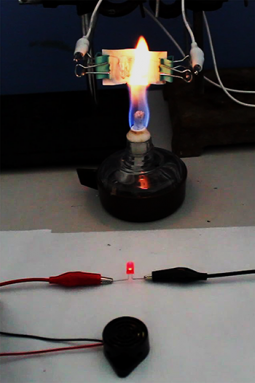Hard-to-burn ‘smart’ wallpaper even triggers alarms
Embedded nanowires respond to heat in a way that can turn on buzzers and warning lights

Wallpaper can give a room pizzazz and personality that a simple paint job won’t achieve. But a new type of wall covering offers to do even more — serve as an alarm system that scouts for signs of fire.
Scovad/iStockphoto
Wallpaper can transform the look of a room. A new type could also do double-duty as a 24/7 fire sentry. This novel “paper” is all but unburnable. And if it gets really hot, the paper will trigger warning lights and sound an alarm.
Researchers in China described their new wall covering March 13 in ACS Nano. They hope the product’s traits will make it attractive for use in homes. One added benefit: It’s nontoxic.
Ying-Jie Zhu works for the Shanghai Institute of Ceramics at the Chinese Academy of Sciences. He led a team that developed the new technology. As a nanostructured-materials scientist, he develops useful materials that contain tiny parts. How tiny? Some parts have a height, width or length that is less than 100 nanometers — or one thousandth the width of a human hair.
Regular paper, including wallpaper, contains cellulose. (Wood is an abundant source of this plant-based product.) But cellulose catches fire easily. So Zhu’s team designed their wall covering be fire resistant. That means it takes a long heating or very hot temperatures to ignite.
Key to the new wallpaper is a network of nanowires inside it. They’re made from hydroxyapatite (Hy-DROX-ee-APP-eh-tyte). It’s a mineral found in bones and teeth. The scientists chose this mineral because it is highly flexible and fire resistant. To make the tiny wires, they added three chemicals — calcium chloride, monosodium phosphate and sodium hydroxide — to a mix of water, an alcohol (methanol) and a dietary fat (oleic acid). Then they heated this recipe for a whole day.

The nanowires are about 10 nanometers wide and at least 100 micrometers long (which is about the thickness of a sheet of printer paper). Those wires naturally weave together. The researchers strengthened the weave by adding glass particles. To make the paper, the scientists pour a liquid containing the nanowires through a paper-making machine. Like regular wallpaper, the end product is smooth and flexible. And though it starts out white, people can dye it different colors or print attractive patterns on it.
The woven network of fibers is linked to a temperature-sensitive sensor on the back of the paper. The sensor is made from a material called graphene (GRAA-feen) oxide. At room temperature, this carbon-based material is an electrical insulator. That means it won’t conduct electricity. But when the temperature climbs above 129° Celsius (264° Fahrenheit), this material’s structure changes. Now it can conduct electricity. And when this happens, the electricity turns on the fire-alarm lamp and buzzer.
To embed this sensor in the wallpaper, the scientists mix graphene oxide in water to create an ink. Then they print it onto the back of the wallpaper. To make the sensor sensitive and resist breakdown, Zhu’s team coats it with a chemical known as polydopamine (PAA-lee-DOAP-uh-meen). It protects the sensor from immediately breaking down in a fire. Within two seconds, high heat will turn on a sensor treated with this chemical. That sensor can survive flames for more than five minutes.
Qunfeng Cheng works at Beihang University in Beijing, China, and was not involved in the new study. As a bioinspired nanomaterials scientist, he looks to structures made by plants and animals as inspiration for new materials. The hardest part of bringing the new wallpaper to market, he suspects, will be to affordably make lots of it. So far, the scientists have only made enough nanowires to cover five square meters (54 square feet) of paper. That is barely enough to cover one wall. To make it attractive for home use, they will have to find a way to make a lot of it inexpensively.
Zhu says his group is talking with a few companies about collaborating. They’re hoping this could lead to enough wallpaper to sell.
“The smart-fire-alarm, fire-resistant wallpaper will be helpful for public safety,” Zhu hopes. If it indeed can be made affordable for widespread use, he said, it holds the prospect of “saving human lives and reducing the loss of property in a fire.”







